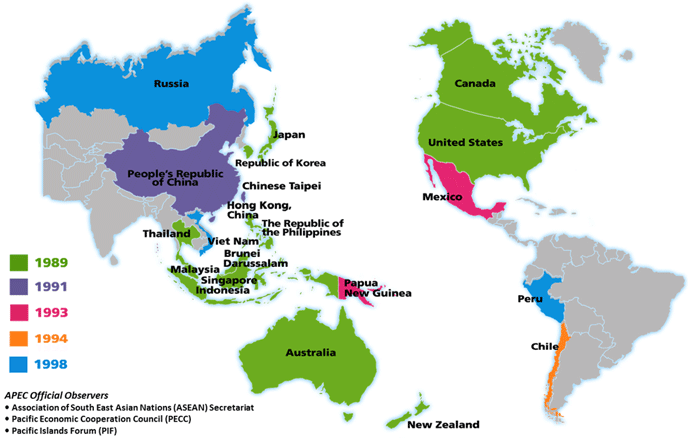The Asia-Pacific Economic Cooperation (APEC) has occupied an important position as a basic framework for Asia-Pacific economic integration and cooperation since its first ministerial meeting in the Australian capital of Canberra in 1989. The 21 economies participating in APEC account for about 40% of the global population, about 50% of global trade and about 60% of global gross domestic product (GDP). Annual APEC ministerial and summit meetings attract wide interest from all quarters. Japan's Ministry of Trade and Industry (now the Ministry of Economy, Trade and Industry) played a great role in the creation of APEC (Note 1). The Free Trade Area of the Asia-Pacific (FTAAP) initiative put forward in the 2010 APEC Yokohama Vision has continued to guide regional economic integration agreements including the Comprehensive and Progressive Agreement for Trans-Pacific Partnership (CPTPP) and the Regional Comprehensive Economic Partnership (RCEP) (Note 2). Will APEC continue to work as an important international framework in the region? In the following, I would like to argue that the APEC Putrajaya Vision 2040, announced in 2020, indicates the future direction of APEC, and discuss the environment surrounding APEC and APEC's roles, looking to the next two decades of APEC.

Putrajaya Vision 2040
APEC is promoting a new vision in the 2020s. Following the Bogor Goals delivered in 1994 and the Osaka Action Guidelines developed in 1995, in 2020 APEC formulated the Putrajaya Vision 2040 and the Aotearoa Plan of Action in 2021. The Putrajaya Vision 2040 states, "Our Vision is an open, dynamic, resilient and peaceful Asia-Pacific community by 2040, for the prosperity of all our people and future generations." It then declared that APEC would pursue three economic drivers: (1) trade and investment, (2) innovation and digitalization, and (3) strong, balanced, secure, sustainable and inclusive growth. The 2021 Aotearoa Plan of Action specified the objectives, the evaluation of progress, individual actions and collective actions regarding the three economic drivers. In the future, specific actions will be implemented in line with the Plan of Action.
Environment surrounding APEC
Since the creation of APEC in 1989, the environment surrounding APEC has changed dramatically. First, China's presence has increased substantially since the 2000s. Regional and free trade agreement negotiations in the Asia-Pacific region have made much progress. In September 2021, China and Taiwan applied to join the CPTPP. Second, great hopes have been placed on the presence in Asia of the United States under the Obama, Trump and Biden administrations. At the October 2021 East Asian Summit, U.S. President Joe Biden delivered the Indo-Pacific Economic Framework. Third, new multilateral forums have been developed in addition to the Group of Seven and APEC, including the Group of 20 and the East Asian Summit. The sharing of roles and cooperation among the multiple forums have become important. Fourth, the world including APEC now faces a new challenge of recovery from the COVID-19 crisis. The world is being forced to enhance supply chains, promote green economy and digital economy initiatives and facilitate human mobility.
APEC's roles
In such circumstances, I would like to make the following three points regarding the roles that APEC should play.
First, APEC should serve as an incubator of ideas. APEC has implemented advanced and ambitious talks and initiatives under its voluntary and nonbinding principles. In 2012, APEC developed a list of environmental goods for tariff reduction and removal, leading to the World Trade Organization's negotiations on an Environmental Goods Agreement. (In 2021, APEC updated the list.) In 2011, APEC created the Cross-border Privacy Rules (CBPR) System, which is used for protecting personal information through corporate validation. (Talks are underway on the expansion of the CBPR system beyond APEC.)
Second, APEC should take advantage of the uniqueness of its membership. The 21 APEC member economies are seven members of the Association of Southeast Asian Nations (excluding Cambodia, Laos and Myanmar), the United States, Canada, Mexico, Peru, Chile, China, Chinese Taipei, Hong Kong, Russia, Australia, New Zealand, Papua New Guinea, South Korea and Japan. While the confrontation between the United States and China is controversial, APEC can provide the two countries with opportunities to discuss their cooperation along with other major regional economies.
Third, APEC as a long-lasting regional framework has robustly developed its institutional frameworks including the secretariat, budgets and committees. It annually implements more than 100 projects for economic and technical cooperation, capacity building and other purposes. Japan has contributed to regional development by carrying out various projects, including training for capacity building for quality infrastructure development and investment, as well as workshops for sharing digital technologies in order to facilitate trade. Through such projects, APEC can be expected to further consolidate development infrastructure for the Asia-Pacific region.
Future prospects
Toward 2040, APEC is assumed to implement agendas for the three economic drivers put forward in the Putrajaya Vision 2040. Within the trade and investment agenda, it may be important for APEC to implement the promotion of a free and fair economic order, the correction of market distorting practices and the maintenance and enhancement of high-level comprehensive economic cooperation. As for the innovation and digitalization agenda, rulemaking and cooperation for realizing the Data Free Flow with Trust (DFFT) initiative will be important. The sustainable and inclusive growth agenda includes the realization of regional carbon neutrality and the provision of stable and affordable energy (Note 3). Thailand, the APEC host for 2022, has put forward "open, connect and balance" as the unifying theme for APEC talks. In 2022, industry-government-academia cooperation in APEC activities is expected to make further progress.


